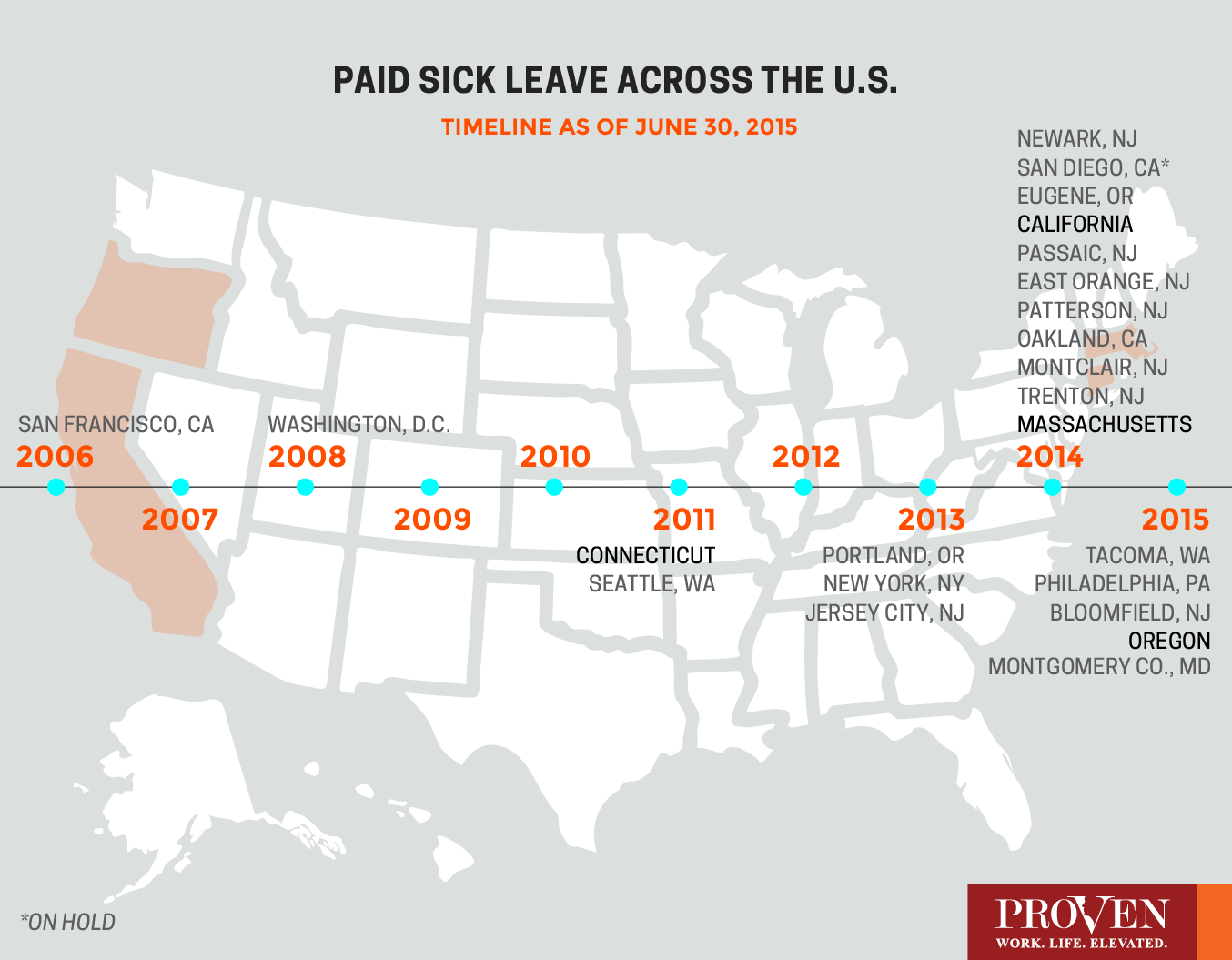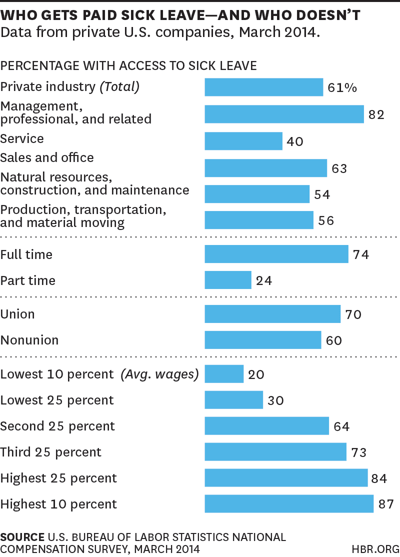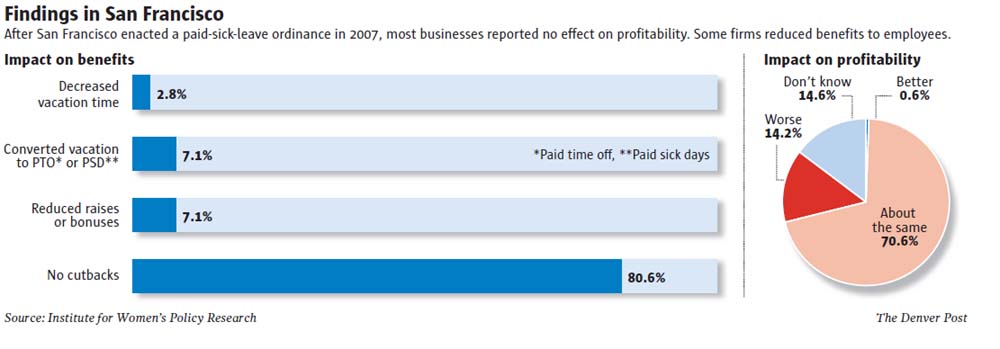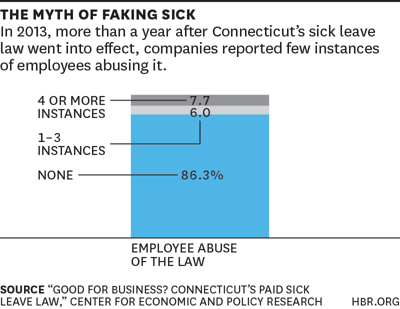As we start to move into cold and flu season, here’s something to think about: 43 million workers in the United States do not have access to paid sick and family leave. Likewise, the U.S. is the only developed country that does not have mandatory national paid maternity leave. So while the federal government continues to struggle to define nationwide standards for employee protections and benefits, workers across the country are forced to choose between a paid day of work and taking care of their family and personal health concerns.
Of course, the Family and Medical Leave Act (FMLA) does provide job-protected leave to eligible employees who need to take leave for family and medical reasons. However, this FMLA leave is unpaid and many employees simply cannot afford to take advantage of it. Thankfully, local and state governments seem to be moving forward where the federal government is not.

Existing Paid Sick Leave Laws
Local governments have led the way in mandatory paid leave laws with cities like San Francisco, New York City, Seattle, Portland, OR, Oakland, Philadelphia, and Newark, NJ all with laws that allow workers to earn paid sick days to recover from short-term illness, care for family members, or seek medical care. There are also nine states, including Hawaii, Maine, Maryland, and Minnesota, that allow some of their workers who already have paid sick days to use them for family members’ health concerns.
Currently, however, there are only three states with statewide mandatory paid sick leave: Connecticut, California, and Massachusetts. In January 2016, they will be joined by Oregon. The Oregon bill requires all employers with 10 or more employees to provide them employees who work in the state with up to 40 hours of paid sick leave per year.
Connecticut
Connecticut was the first state to pass a paid sick leave bill. In 2012, a provision was added to the Connecticut General Statute Code requiring employers in 68 designated service industries with at least 50 employees to allow employees to accrue one hour of paid sick leave for every 40 hours worked. Employees can accrue a maximum of 40 hours of paid sick leave per year, which they can use for their own medical needs or for caring for family members. In 2015, the code was amended to apply to employers with at least 10 employees and also expanded the number of industries affected by the bill.
California
California’s Healthy Workplace Healthy Family Act of 2014 makes it possible for employees working in California, including part-time and temporary employees, to accrue one hour of paid sick leave for every 30 hours worked. California employers can limit the amount of paid sick leave employees can use to 24 hours or three days in one year. Like in Connecticut, employees can use this leave for their own health concerns, preventative care, or to care for a family member. Unlike Connecticut, employees can also use their paid leave to handle issues concerning domestic abuse, sexual assault, or stalking.
Massachusetts
The Massachusetts bill draws heavily on both of its predecessors. It affects all employers in the state, requiring employers with more than ten employees to provide paid sick leave while smaller employers must only offer unpaid time off. Like California, employees will earn one hour of paid leave for every 30 hours worked. The Massachusetts bill allows employees to use paid sick leave in hourly increments if their employer’s payroll system already has the ability to track smaller time increments, while employers can request medical certification if an employee is absent from work for more than 24 consecutive hours.

Looking to the Future
Despite the growing trend among state and local governments to provide workers with appropriate protections and benefits, there is still a frustrating lack of access to paid sick and family leave to the majority of workers across the country.
According to the Harvard Business Review, although local and state progress may create the appearance of improvement in sick and family leave laws, the reality is that there is a “significant divide in terms of who gets paid sick leave.” Simply put, the more you earn, the more likely you are to have access to paid sick and family leave, with full-time management in white-collar jobs receiving the majority of sick leave benefits. This means that the people who need paid leave the most, such as workers in lower income service, part-time, and temporary positions, are out of luck.
Obama's Campaign for Paid Sick Leave
In the capitol, President Obama has made 2015 the year of employee protections and benefits. In January he proposed a policy that would provide all federal workers up to seven days of paid sick leave per year, which they could use for their own health concerns or to care for their families. Throughout the year the President has urged Congress to make paid sick and family leave mandatory in the U.S., calling out our current labor laws as dating back to the 1930s.
Most recently, this September saw President Obama signing an executive order regarding the employees of federal contractors. According to this order, all federal contractors must allow their employees to earn up to seven days of paid sick leave each year, at the standard rate of one hour of paid sick leave for every 30 hours worked. NPR’s report on this executive order stated the President hopes this order will help federal contractors better compete with “model employers” while also boosting efficiency and cost savings.

The Opposition’s Concerns
Regardless of all this apparent momentum, national paid sick and family leave still faces serious opposition. Some politicians and business leaders express concern over the potentially increased appeal of sick leave to their employees. Surely enterprise profitability will decline with more employees willing taking time time off for health and family matters. However, as you can see in the data from 2012 depicted above, San Francisco, which instituted paid sick leave in 2008, saw virtually no effect on business profitability. Employers polled used the addition of required paid sick leave to change or reduce other employee benefits, thereby balancing out profitability.

Likewise, many employers worry that their employees will take advantage of paid sick leave and use that time instead of vacation hours when they are not actually sick. In Connecticut, however, this fear has proven unfounded. In fact, just over a year after Connecticut instituted paid sick and family leave, data shows that only a third of eligible employees actually used their paid leave benefit and, when they did, used fewer days on average than they were designated.
From Washington D.C. to the Nation
As more states and cities continue to establish paid sick and family leave laws, we can only hope that the resulting data is enough to convince the federal government to pass a nationwide policy. Congress has already confirmed that paid leave is high on its agenda for 2016 and there is no doubt that President Obama will continue to push the issue throughout his last year in office.
Meanwhile, in Washington D.C., proposed amendments to the legislature that has provided paid leave for the District’s qualifying workers since 2008 seeks to allot workers sixteen weeks, or four months, of paid family leave per year. This would make the District of Columbia’s paid leave laws the most generous in the country, a great irony when the resident politicians still cannot decide on a federal law making the support of paid sick leave available to workers throughout the country.
Pacific Timesheet provides web-based paid sick time accruals and tracking with our time off software. This software automates everything from employee paid sick time requests, paid sick time approvals and scheduling, and accruals.
To learn more about time off best practices, the free e-book below should be helpful. Let us know about any challenges you have faced complying with new paid sick leave laws




